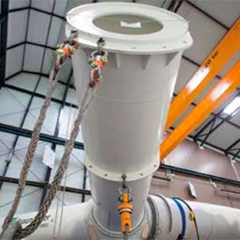Jan Wenske and Maik Wefer of Fraunhofer IWES, show PES how testing should be regarded as a method to accelerate time to market of new designs and stand out by offering approved overall system reliability – instead of restricting the view to the one-time expenses. An opportunity to improve turbines and technology and enhance the competitiveness. The positive outcomes, however, outweigh this expense by far.
What can offshore wind turbine development and wind farm projects be compared to? Certainly not their onshore counterparts. The differences are obvious and include the following: offshore wind turbines are much larger and more powerful, the wind and environmental conditions are quite different, the foundation structures and installation work are more complex, they are connected to the grid via HVDC (high-voltage direct current transmission) or converter stations, undersea cable must be laid and, last but not least, the technical and economic track record of this comparatively young industry is shorter.
However, probably the greatest difference is that offshore turbines are more difficult to get to and access when in operation. Thus, the operation of a turbine in an offshore wind power plant has more similarities with a space mission than onshore wind developments: once the turbine leaves port, any kind of work becomes infinitely expensive and time-consuming or even impossible for long periods. This is why their ultimate success or failure depends to a very significant extent on the technical reliability of components and systems. In the field of offshore wind, general design flaws, poor maintenance concepts, lack of online monitoring and insufficient reliability of parts and systems are a recipe for technical, and therefore economical, failure. We are talking about enormous investment sums in the multiple billions of euros coupled with limited access depending on the environmental conditions in the event of a fault or failure. The manpower, the logistical expense and cost of transportation, be it ship or helicopter, are considerable.


























